
FLU77-4 or equivalent


105-R025D or equivalent
SECTION 417-01: Exterior Lighting
| 2014 Mustang Workshop Manual
|
DIAGNOSIS AND TESTING
| Procedure revision date: 01/07/2013
|
 | Fluke 77-IV Digital Multimeter
FLU77-4 or equivalent |
 | Vehicle Communication Module (VCM) and Integrated Diagnostic System (IDS) software with appropriate hardware, or equivalent scan tool
|
 | Flex Probe Kit
105-R025D or equivalent |
Principles of Operation
NOTE: The Smart Junction Box (SJB) is also known as the Generic Electronic Module (GEM).
The Body Control Module B (BCM-B) monitors the input from the stoplamp switch. When the brake pedal is applied, voltage is routed to the BCM-B . The BCM-B then supplies voltage to the rear stoplamps and high mounted stoplamp.
The ABS module can also send a command to turn the stoplamps on. During an event (such as stability assist) where the ABS module applies the brakes, the ABS module sends a message over the Medium Speed Controller Area Network (MS-CAN) to the BCM-B to turn the stoplamps on.
Field-Effect Transistor (FET) Protection
Field-Effect Transistor (FET) is a type of transistor that when used with module software can be used to monitor and control current flow on module outputs. The FET protection strategy is used to prevent module damage in the event of excessive current flow.
The BCM-B utilizes a FET protective circuit strategy for many of its outputs (for example, a headlamp output circuit). Output loads (current level) are monitored for excessive current (typically short circuits) and are shut down (turns off the voltage or ground provided by the module) when a fault event is detected. A continuous DTC is stored at the fault event and a cumulative counter is started.
When the demand for the output is no longer present, the module resets the FET circuit protection to allow the circuit to function. The next time the driver requests a circuit to activate that has been shut down by a previous short ( FET protection) and the circuit remains shorted, the FET protection shuts off the circuit again and the cumulative counter advances.
When the excessive circuit load occurs often enough, the module shuts down the output until a repair procedure is carried out. Each FET protected circuit has 3 predefined levels of short circuit tolerance based on the harmful effect of each circuit fault on the FET and the ability of the FET to withstand it. A module lifetime level of fault events is established based upon the durability of the FET . If the total tolerance level is determined to be 600 fault events, the 3 predefined levels would be 200, 400 and 600 fault events.
When each tolerance level is reached, the continuous DTC that was stored on the first failure cannot be cleared by a command to clear the continuous DTCs. The module does not allow this code to be cleared or the circuit restored to normal operation until a successful self-test proves that the fault has been repaired. After the self-test has successfully completed (no on-demand DTCs present), DTC U1000:00 and the associated continuous DTC (the DTC related to the shorted circuit) automatically clears and the circuit function returns.
When the first or second level is reached, the continuous DTC (associated with the short circuit) sets along with DTC U1000:00. These DTCs can be cleared using the module on-demand self-test, then the Clear DTC operation on the scan tool (if the on-demand test shows the fault corrected). The module never resets the fault event counter to zero and continues to advance the fault event counter as short circuit fault events occur.
If the number of short circuit fault events reach the third level, then DTC U3000:49 sets along with the associated continuous DTC. This DTC cannot be cleared and the module must be replaced.
The BCM-B FET protected output circuits for the stoplamp system are the high mounted stoplamp and LH/RH rear stoplamp output circuits.
Inspection and Verification
Visual Inspection Chart
| Mechanical | Electrical |
|---|---|
|
|
NOTE: Make sure to use the latest scan tool software release.
If the cause is not visually evident, connect the scan tool to the Data Link Connector (DLC).NOTE: The Vehicle Communication Module (VCM) LED prove-out confirms power and ground from the DLC are provided to the VCM .
If the scan tool does not communicate with the VCM :Symptom Chart
| Condition | Possible Sources | Action |
|---|---|---|
|
|
|
|
| |
|
| |
|
|
Pinpoint Tests
Pinpoint Test I: All The Stoplamps Are Inoperative
Refer to Wiring Diagrams Cell 90 , Turn Signal/Stop/Hazard Lamps for schematic and connector information.
The stoplamp switch is supplied voltage from the Battery Junction Box (BJB) fuse 24 (10A). When the brake pedal is applied, the stoplamp switch routes voltage to the Body Control Module B (BCM-B) indicating a request to turn the high mounted stoplamp and rear stoplamps on.
This pinpoint test is intended to diagnose the following:
NOTICE: Use the correct probe adapter(s) when making measurements. Failure to use the correct probe adapter(s) may damage the connector.
| Test Step | Result / Action to Take |
|---|---|
| I1 CHECK FOR VOLTAGE TO THE STOPLAMP SWITCH | |
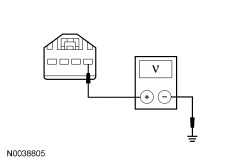 | Yes
GO to I2 . No VERIFY the BJB fuse 24 (10A) is OK. If OK, REPAIR circuit SBB24 (VT/RD) for an open. If not OK, REFER to the Wiring Diagrams Manual to identify the possible causes of the circuit short. |
| I2 BYPASS THE STOPLAMP SWITCH | |
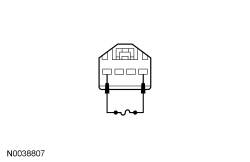 | Yes
REMOVE the jumper wire. INSTALL a new stoplamp switch. REFER to Stoplamp Switch in this section. TEST the system for normal operation. No REMOVE the jumper wire. GO to I3 . |
| I3 CHECK FOR VOLTAGE TO THE BCM-B | |
 | Yes
GO to I4 . No REPAIR circuit CCB08 (VT/WH) for an open. TEST the system for normal operation. |
| I4 CHECK FOR CORRECT BCM-B OPERATION | |
| Yes
INSTALL a new BCM-B . REFER to Section 419-10 . TEST the system for normal operation. No The system is operating correctly at this time. The concern may have been caused by a loose or corroded connector. |
Pinpoint Test J: One Or More Stoplamps Are Inoperative
Refer to Wiring Diagrams Cell 90 , Turn Signal/Stop/Hazard Lamps for schematic and connector information.
When the Body Control Module B (BCM-B) detects the brake pedal is applied, the BCM-B provides voltage to the high mounted stoplamp and each individual LED lamp within the LH and RH rear stoplamps.
| DTC Description | Fault Trigger Conditions |
|---|---|
| A continuous and on-demand DTC that sets when the BCM-B detects a short to ground from the high mounted stoplamp circuit. |
| A continuous and on-demand DTC that sets when the BCM-B detects an open from the high mounted stoplamp circuit. |
| A continuous and on-demand DTC that sets when the BCM-B detects a short to ground from the LH rear inboard stoplamp circuit. |
| A continuous and on-demand DTC that sets when the BCM-B detects an open from the LH rear inboard stoplamp circuit. |
| A continuous and on-demand DTC that sets when the BCM-B detects a short to ground from the RH rear inboard stoplamp circuit. |
| A continuous and on-demand DTC that sets when the BCM-B detects an open from the RH rear inboard stoplamp circuit. |
| A continuous and on-demand DTC that sets when the BCM-B detects a short to ground from the RH rear middle stoplamp circuit. |
| A continuous and on-demand DTC that sets when the BCM-B detects an open from the RH rear middle stoplamp circuit. |
| A continuous and on-demand DTC that sets when the BCM-B detects a short to ground from the LH rear middle stoplamp circuit. |
| A continuous and on-demand DTC that sets when the BCM-B detects an open from the LH rear middle stoplamp circuit. |
| A continuous and on-demand DTC that sets when the BCM-B detects a short to ground from the LH rear outboard stoplamp circuit. |
| A continuous and on-demand DTC that sets when the BCM-B detects an open from the LH rear outboard stoplamp circuit. |
| A continuous and on-demand DTC that sets when the BCM-B detects a short to ground from the RH rear outboard stoplamp circuit. |
| A continuous and on-demand DTC that sets when the BCM-B detects an open from the RH rear outboard stoplamp circuit. |
| A continuous DTC that sets when the BCM-B has temporarily shut down the output driver. The module has temporarily disabled a stoplamp output because an excessive current draw exists (such as a short to ground). The BCM-B cannot enable the stoplamp output until the cause of the short is corrected, the DTCs have been cleared and a successful self-test is run. |
| A continuous DTC that sets when the BCM-B has permanently shut down the output driver. The module has permanently disabled a stoplamp output because an excessive current draw fault (such as a short to ground) has exceeded the limits that the BCM-B can withstand. The cause of the excessive current draw MUST be corrected before a new BCM-B is installed. |
This pinpoint test is intended to diagnose the following:
NOTICE: Use the correct probe adapter(s) when making measurements. Failure to use the correct probe adapter(s) may damage the connector.
| Test Step | Result / Action to Take | ||||||||||||||||
|---|---|---|---|---|---|---|---|---|---|---|---|---|---|---|---|---|---|
| J1 DETERMINE THE INOPERATIVE STOPLAMP | |||||||||||||||||
| Yes
GO to Pinpoint Test I . No For the high mounted stoplamp, GO to J2 . For a LH rear stoplamp, GO to J8 . For a RH rear stoplamp, GO to J17 . | ||||||||||||||||
| J2 CHECK FOR DTC B1270:15 | |||||||||||||||||
| Yes
GO to J3 . No GO to J6 . | ||||||||||||||||
| J3 CHECK FOR VOLTAGE TO THE HIGH MOUNTED STOPLAMP | |||||||||||||||||
 | Yes
GO to J4 . No GO to J5 . | ||||||||||||||||
| J4 CHECK FOR VOLTAGE TO THE HIGH MOUNTED STOPLAMP USING THE CONNECTOR GROUND | |||||||||||||||||
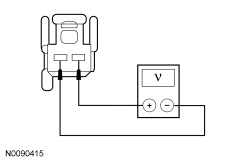 | Yes
INSTALL a new high mounted stoplamp. REFER to High Mounted Stoplamp in this section. TEST the system for normal operation. No REPAIR circuit GD110 (BK/WH) for an open. TEST the system for normal operation. | ||||||||||||||||
| J5 CHECK THE HIGH MOUNTED STOPLAMP SUPPLY CIRCUIT FOR AN OPEN | |||||||||||||||||
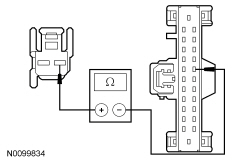 | Yes
GO to J26 . No REPAIR circuit CLS17 (YE/GY) for an open. TEST the system for normal operation. | ||||||||||||||||
| J6 CHECK THE HIGH MOUNTED STOPLAMP FOR A SHORT TO GROUND | |||||||||||||||||
 | Yes
INSTALL a new high mounted stoplamp. REFER to High Mounted Stoplamp in this section. TEST the system for normal operation. No GO to J7 . | ||||||||||||||||
| J7 CHECK THE HIGH MOUNTED STOPLAMP SUPPLY CIRCUIT FOR A SHORT TO GROUND | |||||||||||||||||
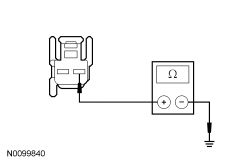 | Yes
GO to J26 . No REPAIR circuit CLS17 (YE/GY) for a short to ground. After the repair: If no DTCs are present, TEST the system for normal operation. If DTC U1000:00 is present, CLEAR the DTCs and REPEAT the self-test (required to enable the stoplamp output driver) . TEST the system for normal operation. If DTC U3000:49 is present, INSTALL a new BCM-B . REFER to Section 419-10 . TEST the system for normal operation. | ||||||||||||||||
| J8 CHECK IF ALL 3 LH STOPLAMPS ARE INOPERATIVE | |||||||||||||||||
| Yes
GO to J9 . No GO to J10 . | ||||||||||||||||
| J9 CHECK THE LH REAR JUMPER HARNESS (ALL 3 LAMPS ARE INOPERATIVE) | |||||||||||||||||
| Yes
REPAIR circuit GD109 (BK) for an open. CLEAR the DTCs. REPEAT the self-test. No REPAIR or INSTALL a new rear lamp jumper harness. CLEAR the DTCs. REPEAT the self-test. | ||||||||||||||||
| J10 CHECK FOR A LH REAR LAMP OPEN CIRCUIT DTC | |||||||||||||||||
| Yes
GO to J11 . No GO to J14 . | ||||||||||||||||
| J11 CHECK FOR VOLTAGE TO THE LH REAR STOPLAMP | |||||||||||||||||
 | Yes
GO to J12 . No GO to J13 . | ||||||||||||||||
| J12 CHECK THE LH REAR LAMP JUMPER HARNESS FOR OPENS | |||||||||||||||||
| Yes
INSTALL a new LED lamp. CLEAR the DTCs. REPEAT the self-test. No REPAIR or INSTALL a new rear lamp jumper harness. CLEAR the DTCs. REPEAT the self-test. | ||||||||||||||||
| J13 CHECK THE BCM-B LH REAR STOPLAMP OUTPUT CIRCUIT FOR AN OPEN | |||||||||||||||||
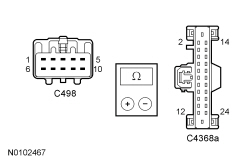 | Yes
GO to J26 . No REPAIR the circuit in question for an open. CLEAR the DTCs. REPEAT the self-test. | ||||||||||||||||
| J14 ISOLATE THE LH REAR LAMP SHORT TO GROUND | |||||||||||||||||
 | Yes
GO to J15 . No GO to J16 . | ||||||||||||||||
| J15 CHECK THE LH REAR LAMP JUMPER HARNESS FOR A SHORT TO GROUND | |||||||||||||||||
| Yes
INSTALL a new LED lamp. CLEAR the DTCs. REPEAT the self-test. No REPAIR or INSTALL a new rear lamp jumper harness. CLEAR the DTCs. REPEAT the self-test. | ||||||||||||||||
| J16 CHECK THE BCM-B LH REAR STOPLAMP OUTPUT CIRCUIT FOR A SHORT TO GROUND | |||||||||||||||||
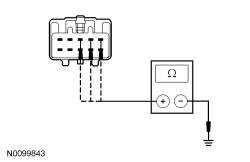 | Yes
GO to J26 . No REPAIR the circuit in question for a short to ground. After the repair: If no DTCs are present, TEST the system for normal operation. If DTC U1000:00 is present, CLEAR the DTCs and REPEAT the self-test (required to enable the stoplamp output driver) . TEST the system for normal operation. If DTC U3000:49 is present, INSTALL a new BCM-B . REFER to Section 419-10 . TEST the system for normal operation. | ||||||||||||||||
| J17 CHECK IF ALL 3 RH STOPLAMPS ARE INOPERATIVE | |||||||||||||||||
| Yes
GO to J18 . No GO to J19 . | ||||||||||||||||
| J18 CHECK THE RH REAR JUMPER HARNESS (ALL 3 LAMPS ARE INOPERATIVE) | |||||||||||||||||
| Yes
REPAIR circuit GD110 (BK/WH) for an open. CLEAR the DTCs. REPEAT the self-test. No REPAIR or INSTALL a new rear lamp jumper harness. CLEAR the DTCs. REPEAT the self-test. | ||||||||||||||||
| J19 CHECK FOR A RH REAR LAMP OPEN CIRCUIT DTC | |||||||||||||||||
| Yes
GO to J20 . No GO to J23 . | ||||||||||||||||
| J20 CHECK FOR VOLTAGE TO THE RH REAR STOPLAMP | |||||||||||||||||
 | Yes
GO to J21 . No GO to J22 . | ||||||||||||||||
| J21 CHECK THE RH REAR LAMP JUMPER HARNESS FOR OPENS | |||||||||||||||||
| Yes
INSTALL a new LED lamp. CLEAR the DTCs. REPEAT the self-test. No REPAIR or INSTALL a new rear lamp jumper harness. CLEAR the DTCs. REPEAT the self-test. | ||||||||||||||||
| J22 CHECK THE BCM-B RH REAR STOPLAMP OUTPUT CIRCUIT FOR AN OPEN | |||||||||||||||||
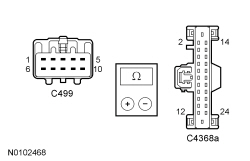 | Yes
GO to J26 . No REPAIR the circuit in question for an open. CLEAR the DTCs. REPEAT the self-test. | ||||||||||||||||
| J23 ISOLATE THE RH REAR LAMP SHORT TO GROUND | |||||||||||||||||
 | Yes
GO to J24 . No GO to J25 . | ||||||||||||||||
| J24 CHECK THE RH REAR LAMP JUMPER HARNESS FOR A SHORT TO GROUND | |||||||||||||||||
| Yes
INSTALL a new LED lamp. CLEAR the DTCs. REPEAT the self-test. No REPAIR or INSTALL a new rear lamp jumper harness. CLEAR the DTCs. REPEAT the self-test. | ||||||||||||||||
| J25 CHECK THE BCM-B RH REAR STOPLAMP OUTPUT CIRCUIT FOR A SHORT TO GROUND | |||||||||||||||||
 | Yes
GO to J26 . No REPAIR the circuit in question for a short to ground. After the repair: If no DTCs are present, TEST the system for normal operation. If DTC U1000:00 is present, CLEAR the DTCs and REPEAT the self-test (required to enable the stoplamp output driver) . TEST the system for normal operation. If DTC U3000:49 is present, INSTALL a new BCM-B . REFER to Section 419-10 . TEST the system for normal operation. | ||||||||||||||||
| J26 CHECK FOR CORRECT BCM-B OPERATION | |||||||||||||||||
| Yes
INSTALL a new BCM-B . REFER to Section 419-10 . TEST the system for normal operation. No The system is operating correctly at this time. The concern may have been caused by a loose or corroded connector. CLEAR the DTCs. REPEAT the self-test. |
Pinpoint Test K: The Stoplamps Are On Continuously
Refer to Wiring Diagrams Cell 90 , Turn Signal/Stop/Hazard Lamps for schematic and connector information.
When the brake pedal is applied, the stoplamp switch routes voltage to the Smart Junction Box (SJB), the PCM and Body Control Module B (BCM-B). When the BCM-B detects the brake pedal is applied, the BCM-B provides voltage to the high mounted stoplamp and the LH/RH rear stoplamps.
| DTC Description | Fault Trigger Conditions |
|---|---|
| An on-demand DTC that sets when the SJB detects a short to voltage from brake pedal input circuit. |
| A continuous and on-demand DTC that sets when the BCM-B detects a short to voltage from the high mounted stoplamp circuit. |
| A continuous and on-demand DTC that sets when the BCM-B detects a short to voltage from the LH rear inboard stoplamp circuit. |
| A continuous and on-demand DTC that sets when the BCM-B detects a short to voltage from the RH rear inboard stoplamp circuit. |
| A continuous and on-demand DTC that sets when the BCM-B detects a short to voltage from the RH rear middle stoplamp circuit. |
| A continuous and on-demand DTC that sets when the BCM-B detects a short to voltage from the RH rear middle stoplamp circuit. |
| A continuous and on-demand DTC that sets when the BCM-B detects a short to voltage from the LH rear outboard stoplamp circuit. |
| A continuous and on-demand DTC that sets when the BCM-B detects a short to voltage from the RH rear outboard stoplamp circuit. |
| A continuous and on-demand DTC that sets when the BCM-B detects a short to voltage from the brake switch circuit. |
This pinpoint test is intended to diagnose the following:
| Test Step | Result / Action to Take |
|---|---|
| K1 DETERMINE IF ALL THE STOPLAMPS ARE ILLUMINATED | |
| Yes
GO to K3 . No GO to K2 . |
| K2 CHECK THE STOPLAMPS VOLTAGE SUPPLY CIRCUIT FOR A SHORT TO VOLTAGE | |
| Yes
For the high mounted stoplamp, REPAIR circuit CLS17 (YE/GY) for a short to voltage. CLEAR the DTCs. REPEAT the self-test. For the LH inboard stoplamp, REPAIR circuit CLS18 (GY/BN) for a short to voltage. CLEAR the DTCs. REPEAT the self-test. For the LH middle stoplamp, REPAIR circuit CLS50 (BN/VT) for a short to voltage. CLEAR the DTCs. REPEAT the self-test. For the LH outboard stoplamp, REPAIR circuit CLS51 (WH/GN) for a short to voltage. CLEAR the DTCs. REPEAT the self-test. For the RH inboard stoplamp, REPAIR circuit CLS19 (VT/OG) for a short to voltage. CLEAR the DTCs. REPEAT the self-test. For the RH middle stoplamp, REPAIR circuit CLS52 (BN) for a short to voltage. CLEAR the DTCs. REPEAT the self-test. For the RH outboard stoplamp, REPAIR circuit CLS53 (GY/VT) for a short to voltage. CLEAR the DTCs. REPEAT the self-test. No GO to K9 . |
| K3 CHECK THE STOPLAMP SWITCH | |
| Yes
GO to K4 . No INSTALL a new stoplamp switch. REFER to Stoplamp Switch in this section. CLEAR the DTCs. REPEAT the self-test. |
| K4 CHECK THE PCM | |
| Yes
GO to K5 . No GO to K7 . |
| K5 CHECK THE SJB | |
| Yes
GO to K6 . No GO to K8 . |
| K6 CHECK FOR VOLTAGE ON THE STOPLAMP SWITCH OUTPUT CIRCUIT | |
 | Yes
REPAIR circuit CCB08 (VT/WH) for a short to voltage. TEST the system for normal operation. No GO to K9 . |
| K7 CHECK FOR CORRECT PCM OPERATION | |
| Yes
INSTALL a new PCM. REFER to Section 303-14 . TEST the system for normal operation. No The system is operating correctly at this time. The concern may have been caused by a loose or corroded connector. |
| K8 CHECK FOR CORRECT SJB OPERATION | |
| Yes
INSTALL a new SJB . REFER to Section 419-10 . TEST the system for normal operation. No The system is operating correctly at this time. The concern may have been caused by a loose or corroded connector. |
| K9 CHECK FOR CORRECT BCM-B OPERATION | |
| Yes
INSTALL a new BCM-B . REFER to Section 419-10 . TEST the system for normal operation. No The system is operating correctly at this time. The concern may have been caused by a loose or corroded connector. CLEAR the DTCs. REPEAT the self-test. |